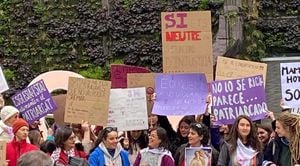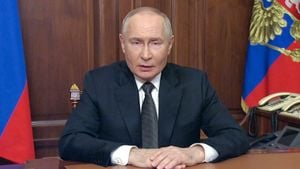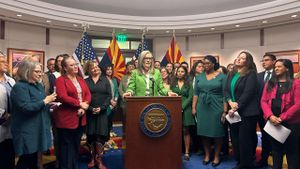Palestinian artists have embarked on a bold initiative to host the Gaza Biennale, which they describe as more than just an art exhibition—it's framed as an act of resistance against the Israeli military offensives inflicted on their homeland. Approximately 50 artists from Gaza have come together to showcase their work, aiming to highlight their rich cultural heritage even amid the extensive hardships they face.
The Gaza Biennale aims to provide these artists with international visibility, showcasing their creations both within the besieged coastal strip and beyond, hopefully finding galleries abroad willing to display their work. Yet, this ambitious project is not without significant hurdles, particularly the challenge of transporting artwork across the harsh Israeli siege lines which limit access to the outside world. According to reports, about 25% of the participating artists managed to escape to Egypt earlier during recent conflicts, leaving many behind to navigate the severe constraints imposed by the blockade.
To adapt to their precarious situation, artists are employing various innovative methods to share their works. Strategies include sending artwork with aid workers when possible, transmitting images and videos electronically, and collaborating with artists from the West Bank to reimagine their pieces remotely. Tasneem Shatat, one of the project’s driving forces, expressed the significance of calling the event a biennale, stating, "The biggest artistic events in the world are called biennales, hosting the world’s most important artists to address the most important things through their art. For us, the most important artists right now are the artists of Gaza." This decision also connotes resilience, reinforcing the idea this will become a recurring event.
The initiative originated during conversations among artists who were systematically checking on each other during the chaos, sharing stories of survival and the determination to continue creating art, even with severely limited resources. Shatat poignantly conveyed the gravity of their mission, saying, "The war stole many things from us and the people of Gaza; it continues to take everything, and yet the world stays silent. We want international institutions to display our art, which tells the rebirth of the darkness of injustice through our experiences. It’s about life amid death."
The Gaza Biennale’s organizers claim this undertaking would be unprecedented—a gathering of artists under siege finding ways to present their work on the international stage, reinforcing the narrative of survival and resistance.
One artist, Muhammad al-Hajj, continues to sketch even as he dodges bombings and copes with scarcity. He shared the stark reality of his situation from the central area of the Gaza Strip, stating, "There’s no food or water, and we are on the verge of winter. I lack basic supplies like pens and paints, and when they are available, they’re ridiculously overpriced." Hajj reminisced about his former studio, which has since been lost, noting his plans to export allegorical drawings of Palestinian suffering either through collaboration with artists across the border or electronically capturing his work for reproduction.
Meanwhile, Rufaida Sehwail, who has seen her life shattered after being displaced seven times due to bombing, also contributed to the project. She lost not only her home but 17 years of artistic work and her extensive library. For her, the Gaza Biennale offers hope—a chance for rediscovery and continuity through her creations. "Continuing to create art in the midst of war is not just creativity, it’s survival itself. While Israel focuses on erasing life and culture here, by creating, I reaffirm our identity cannot be erased," she declared with unwavering determination.
The manifesto launching the Gaza Biennale proclaims its mission: to step outside traditional exhibition frameworks, reflecting cultural sensitivities and underlining the urgent struggle for survival. It’s intended to document not merely suffering but to assert the vibrancy and resilience of Palestinian culture.
While the Gaza Biennale project is still at its nascent stage and relies heavily on establishing connections with international galleries to materialize, its initiators remain optimistic. Shatat prophetically remarked, "All artists’ works will come out. They will see the light, and they will cross barriers and borders, ensuring the world sees them. This is the power of art." The group has even initiated crowdfunding efforts to secure resources, advocating for support to amplify their message through art.



